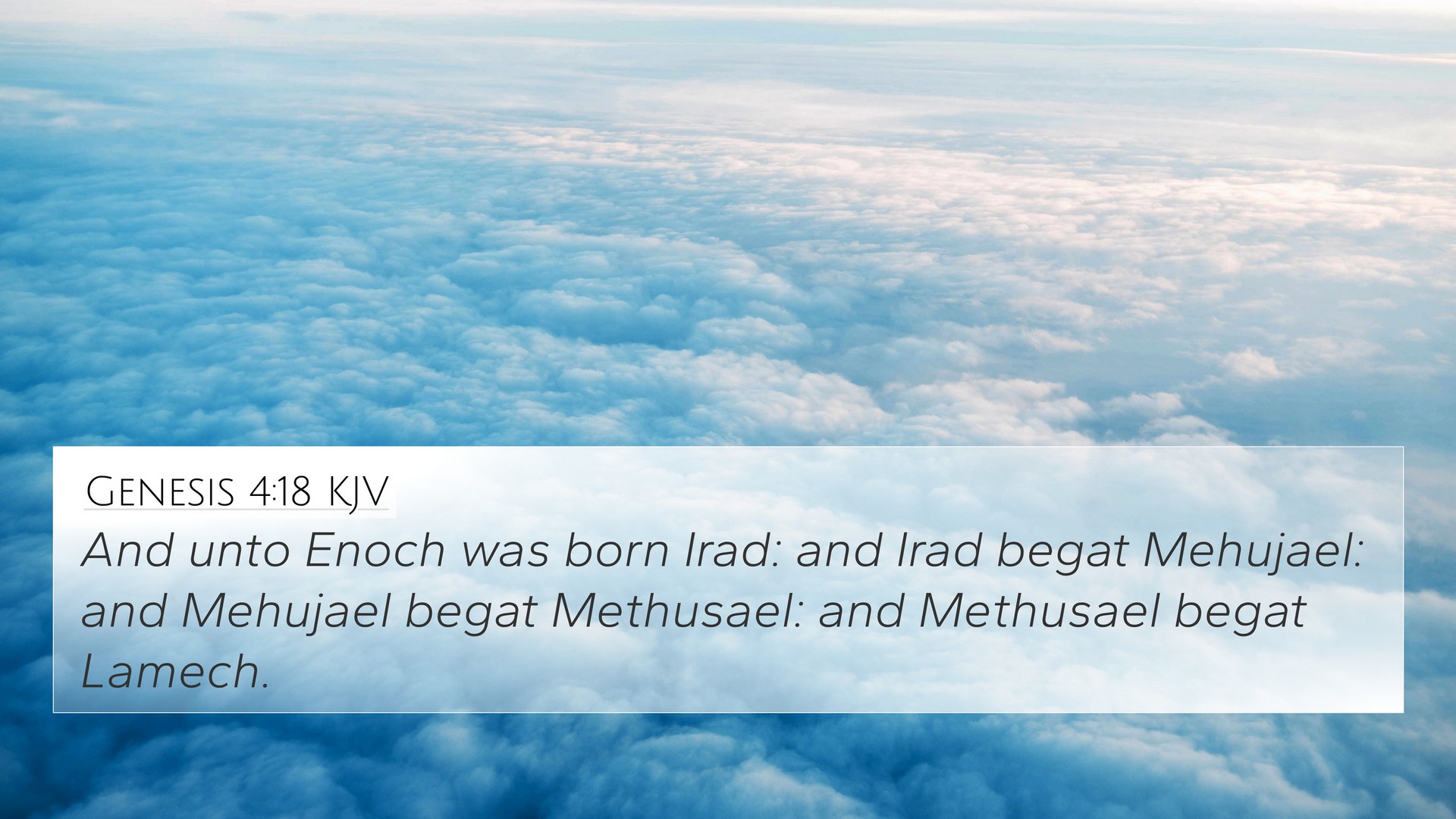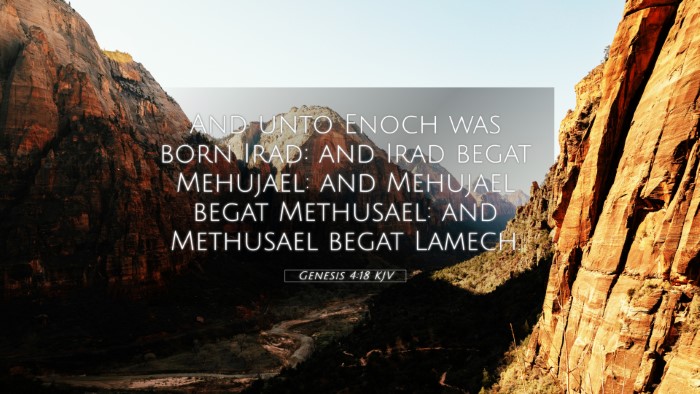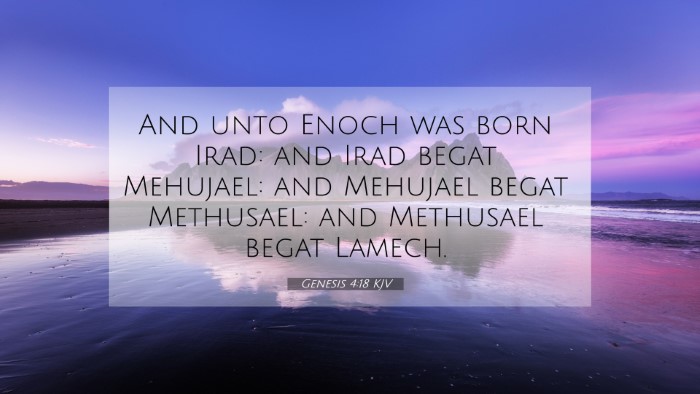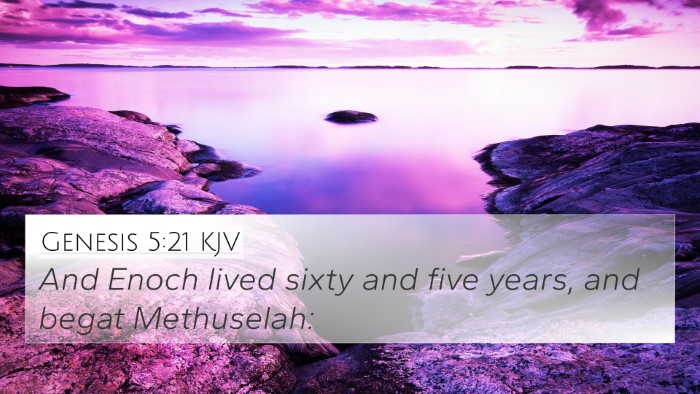Understanding Genesis 4:18
Genesis 4:18 reads: "And Enoch was born to Irad; and Irad begot Mehujael; and Mehujael begot Methusael; and Methusael begot Lamech."
This verse presents a genealogical record that follows the lineage of Cain, indicating the ongoing legacy of his descendants.
Understanding this verse requires exploration of its context and implications as interpreted by various Biblical commentators.
Genealogical Significance
The genealogy outlined in Genesis 4:18 is crucial for establishing the historical and spiritual lineage stemming from Cain,
juxtaposed against the lineage of Seth in subsequent chapters.
Matthew Henry suggests that this lineage reflects the proliferation of sin, as it stems from Cain, who is marked by his transgressions.
Albert Barnes emphasizes that the names in this genealogy carry meanings that might reflect certain qualities or traits of the individuals,
potentially indicating the character or the moral standing of the descendants.
This warrants a deeper exploration of how biblical names often correlate with narratives or life outcomes.
Adam Clarke adds that such genealogies serve not only to record lineage but to highlight divine providence in maintaining human history
despite the scars of sin that began with Adam and Eve.
Thematic Connections
When considering Bible verse cross-references, Genesis 4:18 has thematic links to several scriptural passages:
- Genesis 4:10-12: The consequences of Cain’s actions provide a backdrop for understanding the nature of sin and its offspring.
- Genesis 5:1-32: The contrasting lineage of Seth reflects on the righteousness in contrast to Cain’s descendants.
- 1 John 3:12: This New Testament verse discusses Cain's evil act and serves to give a moral framework to the examined genealogy.
- Luke 3:37: The genealogy of Jesus traces back to Adam, reflecting the connection between the line of Seth and God's redemption plan.
- Hebrews 11:4: Acknowledging Abel's commendation establishes a contrast to Cain's lineage, focusing on faith.
- Revelation 21:8: The final judgment reflects on those who have strayed from righteousness, reminding us of the consequences that stem from Cain's actions.
- Matthew 23:35: Jesus speaks of the blood of the righteous Abel, further drawing a line between spiritual lineage marked by righteousness versus sin.
Utilizing Biblical Tools for Cross-Referencing
To delve deeper into Genesis 4:18 and its themes, one may consider utilizing various tools for bible cross-referencing:
- Bible concordance: A resource that lists key terms and enables users to find verses of similar themes or concepts.
- Bible reference resources: These can include study Bibles and tools that present parallel passages for enhanced understanding.
- Cross-reference Bible study methods: Employ methods that trace themes and narratives across the Scriptures, linking books of the Bible together.
Inter-Biblical Dialogue
The passage in Genesis prompts questions about the nature of humanity as marked by sin, as well as God's plan for redemption through Jesus—elements that can be seen evolving throughout Scripture.
Such dialogues across the Bible can provide profound insights:
- Identifying connections between Old and New Testament: Understanding how the themes of genealogy and legacy play out from Genesis to the Gospels.
- Detailed cross-reference between Gospels: Exploring how the genealogies found in Matthew and Luke contrast and complement one another.
- Cross-referencing Psalms with New Testament teachings: Psalmist reflections on sin can shed light on the realities portrayed in Genesis.
Concluding Insights
Genesis 4:18, although succinct, holds profound implications for understanding sin, morality, and the human condition in the Biblical narrative.
By examining the genealogical records and their implications, we can identify crucial themes that recur throughout the Scripture.
The connections established through scriptural cross-referencing enhance our comprehension of the Bible as a cohesive narrative
underscoring God's redemptive work through various lineages and characters.
Future studies may focus on how these foundational narratives inform contemporary understanding of morality,
ethical living, and the overarching theme of redemption that weaves its way from Genesis to Revelation.




